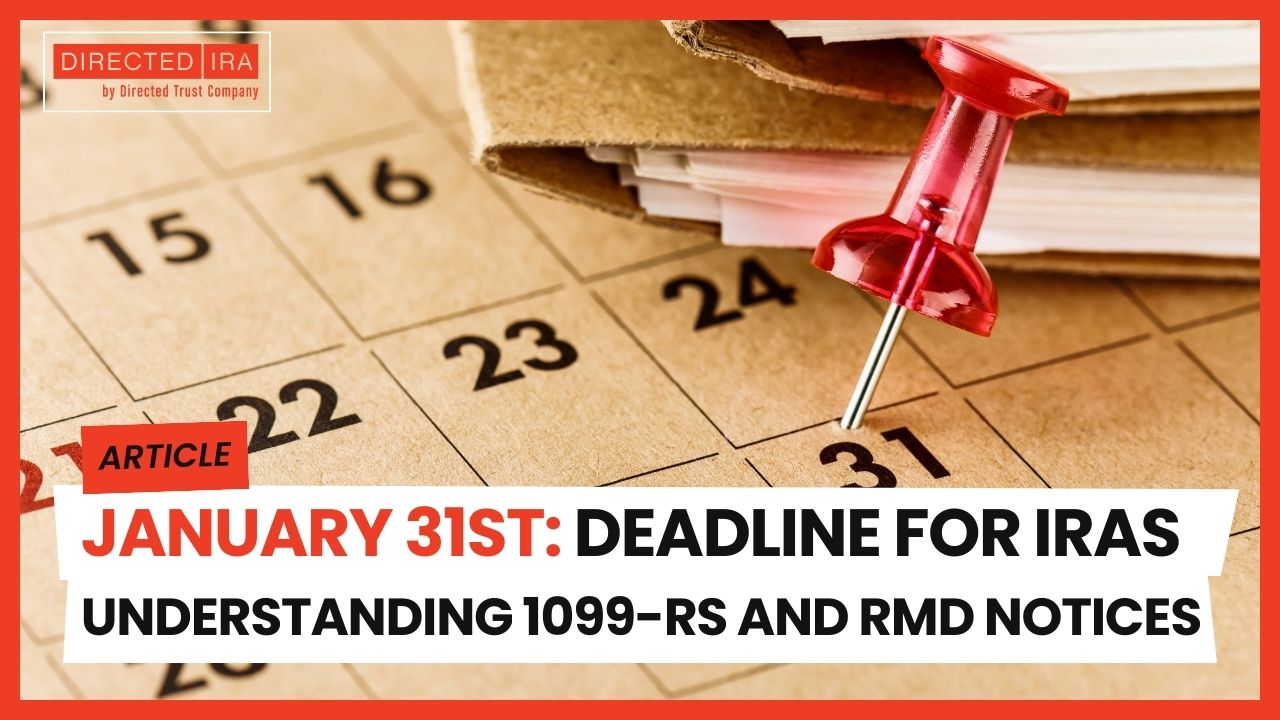The start of a new year brings a series of important deadlines and requirements for Individual Retirement Arrangements (IRAs). January 31st is the first date for IRA owners to be aware of. This is the deadline for financial institutions and IRA custodians to send out two key documents: 1099-Rs and Required Minimum Distribution (RMD) notices, if applicable. Below, we’ll discuss the significance of the January 31st deadline and why you should be prepared to receive these documents.
1099-R Forms: A Recap
The 1099-R reports distributions or Roth conversions from retirement accounts. It provides critical information about the amount distributed, the type of distribution (e.g., regular distribution, early withdrawal, rollovers, Roth conversions), and the applicable tax codes for those transactions.
For Self-Directed IRA, 1099-R forms are essential for accurately reporting income and ensuring compliance with IRS regulations. If you’ve made withdrawals, converted assets, or taken other distribution actions within your Self-Directed IRA during the previous tax year, you can expect to receive a 1099-R form that will be sent out by January 31st. If you’ve taken a 60-day rollover from an IRA or 401(k) (a 1099-R is issued in this instance) and redeposited the funds within 60 days, you must properly report this on your 1040 to avoid taxes and penalty.
RMD Notices: A Reminder of Your Responsibilities
Another critical document sent out by January 31st is the Required Minimum Distribution (RMD) notice. RMDs are mandatory withdrawals that individuals with traditional IRAs or employer-sponsored retirement plans must take once they reach a certain age, usually beginning at age 72 (or 73 if you reach age 72 after December 31, 2022). Self-Directed IRAs are no exception to this rule.
The RMD notice reminds IRA account holders that they must withdraw a specific minimum amount from their retirement accounts each year to avoid penalties. The required minimum distribution is calculated based on factors such as age and your IRA holdings’ total value.
Why the January 31st Deadline Matters for 1099-R forms and RMD notices
1. Tax Reporting: The information on the 1099-R form is essential for correctly reporting your retirement account transactions on your tax return. Failing to include this information or making errors can result in penalties or taxes. Failure to not properly report a 60-day rollover 1099-R will cause taxes, penalties, and distribution.
2. RMD Compliance: Receiving your RMD notice by January 31st ensures ample time to calculate and execute your required minimum distribution for the year by December 31st (or April 1st of the following year if this is your first RMD). Missing the deadline can result in a 50% penalty on the amount you did not take out as a distribution.
3. Planning and Budgeting: These documents are not just for tax purposes; they also help you plan and budget for the year ahead. Knowing the exact amounts of your distributions can be crucial in managing your finances during retirement.
What About IRS Form 5498
Depending on your self-directed IRA investments, you may be required to file IRS Form 5498 for your IRA’s investments/income.
- What’s the Purpose: Filed to the IRS by your custodian. No taxes are due or paid as a result of Form 5498.
- What Does it Report: IRA contributions, Roth conversions, the account’s fair market value as of 12/31 of the current year, and required minimum distributions taken.
- Due Date: May 31st, 2024.
What to Do If You Don’t Receive Your Documents
If you do not receive your 1099-R form or RMD notice by the January 31st deadline (or shortly after to allow for mail time), taking action promptly is essential. Contact your IRA custodian or financial institution to inquire about the status of these documents.
In summary, the January 31st deadline for a Self-Directed IRA account is important to have on your radar. Receiving your 1099-R forms and RMD notices by this date ensures that you comply with IRS regulations, correctly report your income, and meet your required minimum distribution obligations. Stay proactive in monitoring your mailbox (or email inbox if you opt to receive these notices electronically) for these essential documents, and if they do not arrive on time, take immediate steps by contacting your IRA custodian or financial institution. By staying on top of these deadlines, you can continue enjoying the benefits of your Self-Directed IRA and peace of mind in your retirement years.
Thanks for reading. If you have any questions about setting up a new Self-Directed IRA, Solo(k), HSA, Coverdell/ESA, and more – book a free call with us here to learn more.
Use promo code BLOG50 to get $50 off your new account set-up fees.

